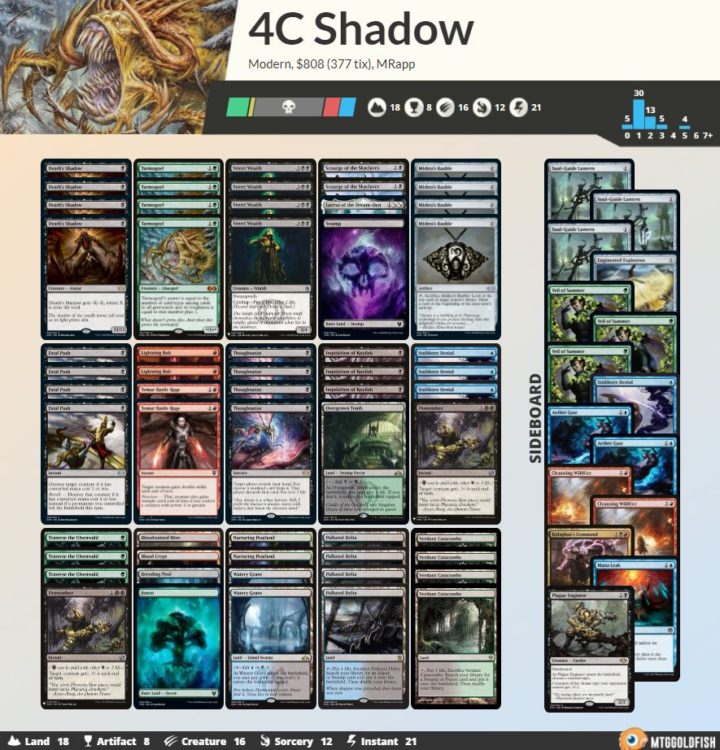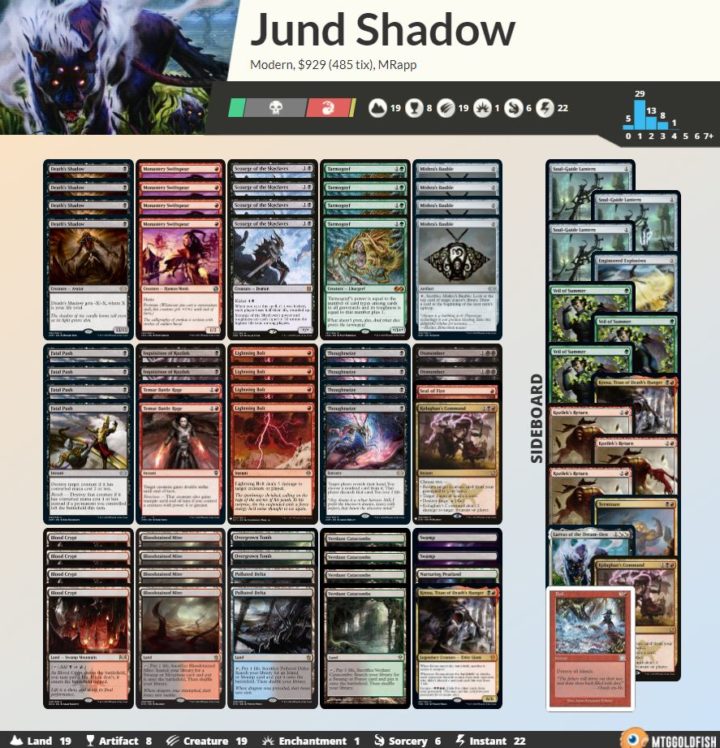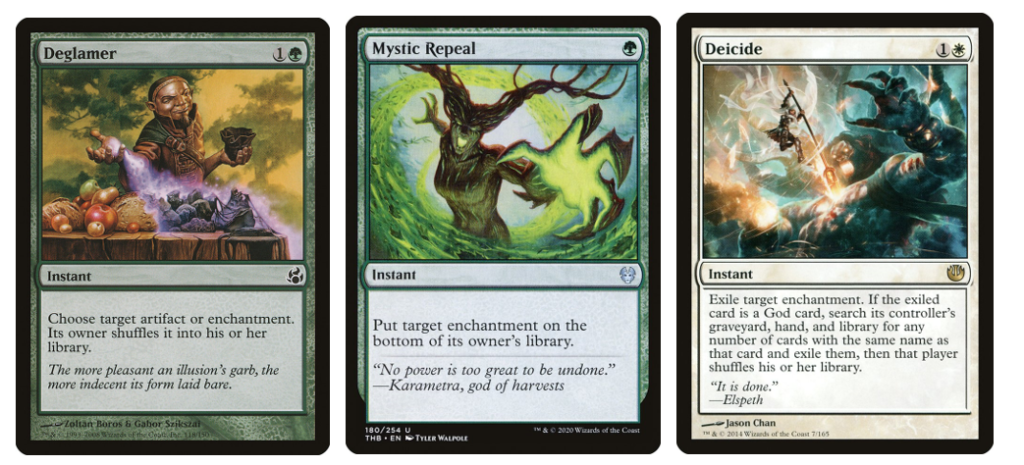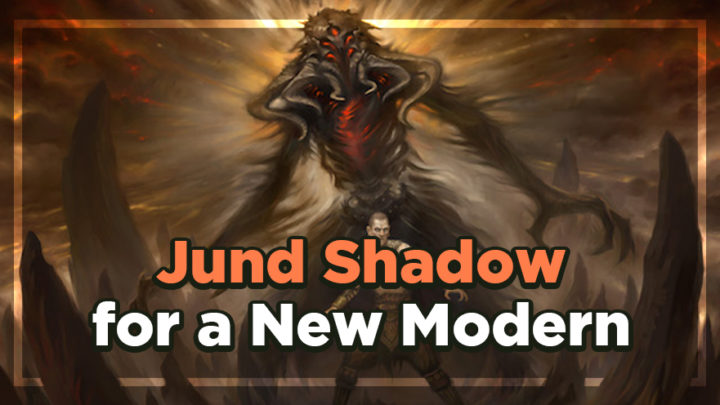Uro, Titan of Nature’s Wrath, Field of the Dead, Simian Spirit Guide, and Mystic Sanctuary have been banned in Modern. Modern players around the world rejoiced upon hearing the news, myself included. But once I was done celebrating, I knew that I’d have to get back into the lab to try and crack the code for the new Modern format.
Naturally the first place I (and many others) turned was Death’s Shadow. Rakdos was already a tier one option with Uro and friends legal; it’s only natural to think the deck would have room to grow with its most powerful predator gone. I put together a couple lists that I thought were good starting points, but as I kept thinking about the changes that would come from the bans, I realized that players would start to gravitate toward fair decks that had been pushed out by Uro for the last year. After doing some browsing through Twitter, my suspicions were confirmed — Jund, Stoneblade, and Shadow seemed to be the consensus winners. It also seems that the Simian Spirit Guide ban has left combo players lost for what to do, while Field of the Dead has taken Amulet Titan off the menu for now.
After reviewing this data, I began to think that Rakdos may not be the best choice, especially if Fatal Push and Archmage’s Charm are likely to be popular. Rakdos just doesn’t really have the staying power that is needed to keep up with bigger midrange decks. I needed something else.
Four-Color Shadow
Four-Color Shadow gave me access to Tarmogoyf and Veil of Summer. Tarmogoyf is one of the key additions I was looking for to help with the Prowess match-up and serve as an additional threat in Shadow mirrors. The fairer Modern is, the better Veil of Summer is, and judging by how the metagame is shaping up, I wouldn’t leave home without it.

It turns out I overestimated players’ desire to continue playing combo decks — the primary reason to add blue to a Shadow deck. I also lost access to Lurrus of the Dream-Den as a companion in order to properly support Traverse the Ulvenwald, which hinders this version’s ability to grind against other midrange decks. It just so happened that I wasn’t seeing nearly any combo or big mana decks in my testing, so it was time to adjust.
Jund Shadow

Here’s an updated version of the decklist I played to a Top 4 finish in the Modern Challenge last Sunday, and used to qualify for the Manatraders series. I cut the Liliana of the Veil from the sideboard because I forgot that it doesn’t work with Lurrus in the companion slot, and I added a Kozilek’s Return.
Trimming the blue cards made the mana base significantly more reliable. Jund Shadow also has a more focused plan: get on the board early with Monastery Swiftspear and Tarmogoyf to set up Scourge of the Skyclaves and Death’s Shadow to win the game.
Whenever Modern changes, I tend to classify decks as either Decks That Do Things or Decks That Don’t. Decks That Do Things are proactive decks with a solid plan. Especially early on, Decks That Do Things tend to have an advantage over Decks That Don’t, simply because those decks haven’t figured out the correct configuration of answers just yet.
Jund Shadow is certainly a Deck That Does Things. While this is good for beating up on people trying new things, it can cost you some equity once people figure out how to effectively build reactive decks. That being said, I believe Modern still favors Jund’s ability to get on the board and be disruptive, in large part because there simply hasn’t been much spell-based combo around at all.
Card Choices

Let’s start with some notable exclusions. If you look at stock Jund Shadow lists, you’d likely find some way to interact with lands, be it Blood Moon or Cleansing Wildfire. I started with Cleansing Wildfire as a way to gain ground in the Tron and Amulet match-ups. But over the course of 50 matches or so, I hadn’t played against Primeval Titan at all, and only played against Tron once. That being said, if those decks become popular again, adding Cleaning Wildfire back into the mix seems smart.

Traverse the Ulvenwald is a longtime staple in both Jund and Four-Color Shadow, but it didn’t make the cut this time. When I was building my take on Jund Shadow, I wanted to just be a slightly bigger version of Rakdos Shadow that played the best green cards. Building Jund Shadow without Traverse lets you emulate that aggressive playstyle, and you get to keep Lurrus as a companion. Traverse Shadow is strong in its own right if the metagame demands that Shadow decks slow down and trade some explosiveness for raw power, and we could certainly see that move in the future.

Engineered Explosives is a hotly debated card in the Shadow community. Given how powerful it is against us, some people are worried that it might not be a smart inclusion. Engineered Explosives is one of only a few cards that fits under the Lurrus restrictions that is excellent against Prowess, all of the tribal decks, and Hammer Time. My stance on the matter is that the first copy of Engineered Explosives in a Lurrus deck has a ton of value. You get to decide when you cast and activate it, which means that you control the risk associated with collateral damage.

Soul-Guide Lantern vs. Nihil Spellbomb are two more cards the community tends to disagree about. For a long time, I’ve been on the Soul-Guide Lantern side, especially when Oops All Spells and Uro were popular. Beating Leyline of Sanctity was important against Oops, and exiling Uro without having to commit to sacrificing the Lantern was a big upside in those match-ups. That being said, Nihil Spellbomb is better in the Lurrus mirrors and when Leyline of Sanctity isn’t popular — you get the graveyard hate and a card back instead of one or the other. Oops has fallen off enough, and Dredge players have mostly left Leyline behind, so moving to Nihil Spellbomb is likely safe.

Seal of Fire is my last real flex spot. It may look underwhelming on its face, but a repeatable Shock against creature decks that also puts enchantment in the graveyard for Tarmogoyf earns its spot in the current meta.
The Value of Targeted Sideboards
Traditionally, midrange decks in Modern have tried to cover as many match-ups as possible with their sideboard cards. I believe this is largely an antiquated way of thinking if you want to maximize your tournament equity. While it is more work — and requires a deeper understanding of your deck, playstyle, and the metagame — you will be rewarded if you identify which decks you’re trying to beat, or need the most help against, and specifically target those archetypes when you build your sideboard.

Going into the Challenge on Sunday, I decided that I needed a strong plan for Auriok Champion decks, Fatal Push midrange decks, Blue-based control decks, and graveyard decks. As a result, you’ll find some unconventional numbers in my list, such as three Kozilek’s Returns. It isn’t the best sweeper available to Jund Shadow, but it is the best sweeper that kills Auriok Champion. I also knew there was a chance that I could end up playing against decks like Burn and Tron that I chose not to include sideboard cards for, but I knew they were relatively unpopular. Including cards to effectively fight those match-ups would take away from my ability to have strong plans against the decks I wanted to beat.
The Elephant in the Room
I won’t mince words here: the Heliod combo match-up is rough. They’re usually playing 3-4 Auriok Champions in the main deck, which causes some problems. And things only get worse thanks to Heliod, Sun-Crowned: a Terminate machine for Death’s Shadow and Scourge of the Skyclaves due to its ability to give lifelink to any creature.

I’m not particularly worried about the combos the Heliod deck can present because of how removal-dense Jund Shadow is in post-board games. Auriok Champion and Heliod are each beatable if you prepare for them, but the real problems arise when they’re together. You’re often pressured to kill the Heliod player in one attack because your Death’s Shadows and Scourges are unlikely to live through combat with a Heliod on the field, but Auriok Champion provides a nearly unkillable blocker.
Naturally, we should look for ways to deal with Heliod, as going around Auriok Champion is a reasonable plan if the pesky god isn’t involved. Pithing Needle is the cleanest answer, but it doesn’t stop the Spike Feeder combo and it gets tagged by Skyclave Apparition. Under normal circumstances, I wouldn’t consider “dying to removal” a great reason not to play a card, but in this case, it has to work. The same is true for Rain of Gore and all of the other permanent-based hate Jund Shadow can reasonably play.
This means that we need to look for spell-based ways to interact with an indestructible enchantment in Jund colors… and the list is pretty short. The best options are Deglamer and Mystic Repeal. While these seem like reasonable options, they also have a flaw: Collected Company and Eladamri’s Call make it easy for the Heliod player to find another copy of the deck’s signature card. So, it was time for me to do some digging.

After talking with some friends, the best thing we came up with was Deicide. I bet most of you had to look that one up, because — well, it hasn’t seen much play in Modern before. You may have also noticed that it’s a white card, and that’s how I ended up with this deck…
Jund Shadow – White Splash

This isn’t too much of a departure from the previous Jund list. I cut the second Swamp (which I didn’t like that much to begin with) for a Godless Shrine in order to support the sideboard splash. Two copies of Deicide, three copies of Kozilek’s Return, and an Engineered Explosives will hopefully turn the Heliod match-up positive.
While the Kaya’s Guile isn’t for the Heliod match-up per se, it is pretty close to free to include once you have access to white mana. It’s excellent in the Shadow mirrors, or against any other deck with large creatures. It also isn’t much worse than Lantern against the graveyard decks, and it gives the deck something against Burn while also being reasonable against Prowess.
I’m likely to register this or something very close for the Manatraders series this weekend, and I’m hoping my adventure down the rabbit hole ends up being fruitful.
I’ve been having a blast with the newly revived Modern, and hope to bring you all some more sweet decks soon enough. If you want to see my cover anything specific, or just have questions or comments, feel free to reach out on Twitter at @RappaciousOne. Until next time, have fun, and be safe!

Michael Rapp is a Modern specialist who favors Thoughtseize decks. Magic sates his desire for competition and constant improvement.

